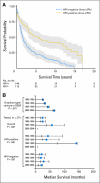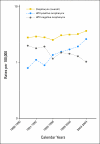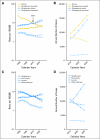Human papillomavirus and rising oropharyngeal cancer incidence in the United States
- PMID: 21969503
- PMCID: PMC3221528
- DOI: 10.1200/JCO.2011.36.4596
Human papillomavirus and rising oropharyngeal cancer incidence in the United States
Abstract
Purpose: Recent increases in incidence and survival of oropharyngeal cancers in the United States have been attributed to human papillomavirus (HPV) infection, but empirical evidence is lacking.
Patients and methods: HPV status was determined for all 271 oropharyngeal cancers (1984-2004) collected by the three population-based cancer registries in the Surveillance, Epidemiology, and End Results (SEER) Residual Tissue Repositories Program by using polymerase chain reaction and genotyping (Inno-LiPA), HPV16 viral load, and HPV16 mRNA expression. Trends in HPV prevalence across four calendar periods were estimated by using logistic regression. Observed HPV prevalence was reweighted to all oropharyngeal cancers within the cancer registries to account for nonrandom selection and to calculate incidence trends. Survival of HPV-positive and HPV-negative patients was compared by using Kaplan-Meier and multivariable Cox regression analyses.
Results: HPV prevalence in oropharyngeal cancers significantly increased over calendar time regardless of HPV detection assay (P trend < .05). For example, HPV prevalence by Inno-LiPA increased from 16.3% during 1984 to 1989 to 71.7% during 2000 to 2004. Median survival was significantly longer for HPV-positive than for HPV-negative patients (131 v 20 months; log-rank P < .001; adjusted hazard ratio, 0.31; 95% CI, 0.21 to 0.46). Survival significantly increased across calendar periods for HPV-positive (P = .003) but not for HPV-negative patients (P = .18). Population-level incidence of HPV-positive oropharyngeal cancers increased by 225% (95% CI, 208% to 242%) from 1988 to 2004 (from 0.8 per 100,000 to 2.6 per 100,000), and incidence for HPV-negative cancers declined by 50% (95% CI, 47% to 53%; from 2.0 per 100,000 to 1.0 per 100,000). If recent incidence trends continue, the annual number of HPV-positive oropharyngeal cancers is expected to surpass the annual number of cervical cancers by the year 2020.
Conclusion: Increases in the population-level incidence and survival of oropharyngeal cancers in the United States since 1984 are caused by HPV infection.
Conflict of interest statement
Authors' disclosures of potential conflicts of interest and author contributions are found at the end of this article.
Figures




Republished in
-
Human Papillomavirus and Rising Oropharyngeal Cancer Incidence in the United States.J Clin Oncol. 2023 Jun 10;41(17):3081-3088. doi: 10.1200/JCO.22.02625. J Clin Oncol. 2023. PMID: 37285653 Free PMC article.
Comment in
-
Implications of the oropharyngeal cancer epidemic.J Clin Oncol. 2011 Nov 10;29(32):4222-3. doi: 10.1200/JCO.2011.37.8893. Epub 2011 Oct 3. J Clin Oncol. 2011. PMID: 21969506 Free PMC article. No abstract available.
References
-
- D'Souza G, Kreimer AR, Viscidi R, et al. Case-control study of human papillomavirus and oropharyngeal cancer. N Engl J Med. 2007;356:1944–1956. - PubMed
-
- Herrero R, Castellsagué X, Pawlita M, et al. Human papillomavirus and oral cancer: The International Agency for Research on Cancer multicenter study. J Natl Cancer Inst. 2003;95:1772–1783. - PubMed
-
- Applebaum KM, Furniss CS, Zeka A, et al. Lack of association of alcohol and tobacco with HPV16-associated head and neck cancer. J Natl Cancer Inst. 2007;99:1801–1810. - PubMed
-
- Smith EM, Ritchie JM, Summersgill KF, et al. Human papillomavirus in oral exfoliated cells and risk of head and neck cancer. J Natl Cancer Inst. 2004;96:449–455. - PubMed
-
- Schwartz SM, Daling JR, Doody DR, et al. Oral cancer risk in relation to sexual history and evidence of human papillomavirus infection. J Natl Cancer Inst. 1998;90:1626–1636. - PubMed
Publication types
MeSH terms
Grants and funding
LinkOut - more resources
Full Text Sources
Other Literature Sources
Medical

